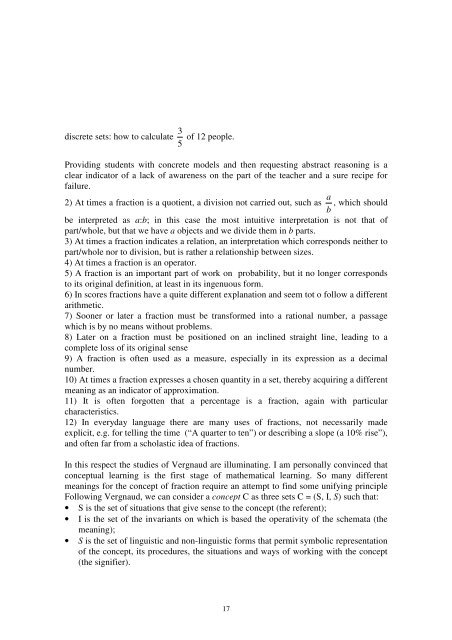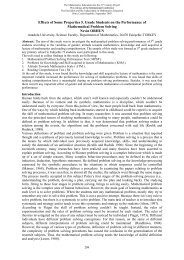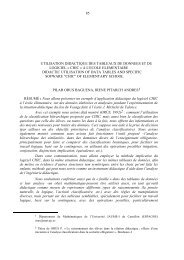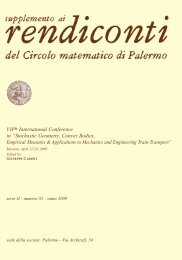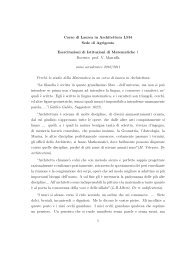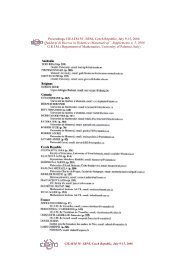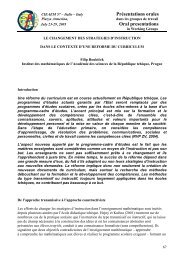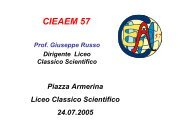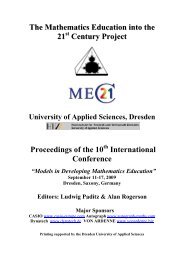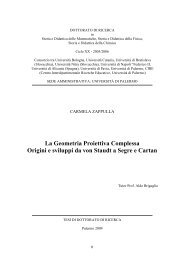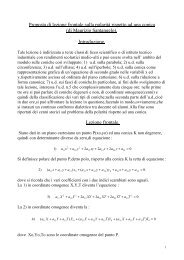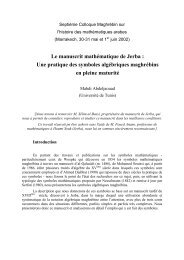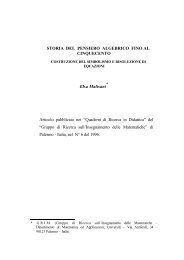- Page 1: CONTENTS 1. Fractions: conceptual a
- Page 4 and 5: In this way the initial set N×(N-{
- Page 6 and 7: Thus fractions, while not a part of
- Page 8 and 9: Ellerbruch, 1975; Minskaya, 1975; K
- Page 10 and 11: accompanies them in the field of
- Page 12 and 13: There are many studies based on cla
- Page 14 and 15: primary classes. The study focuses
- Page 18 and 19: Thus it is evident that the choice
- Page 20 and 21: We can pass to other examples, abst
- Page 22 and 23: (a) The image of a whole divided in
- Page 24 and 25: Behr M.J., Wachsmuth I., Post T. (1
- Page 26 and 27: multiplicative reasoning in the lea
- Page 28 and 29: Duval R. (1995). Sémiosis et pens
- Page 30 and 31: Hunting R.P., Pepper K.I., Gibson S
- Page 32 and 33: Novillis C.F. (1976). An analysis o
- Page 34 and 35: Steffe L.P., Olive J. (1990). Const
- Page 36 and 37: Vogel K. (1958). Vorgriechische mat
- Page 38 and 39: Indice Prefazione di Athanasios Gag
- Page 40 and 41: 7.1.8. Difficoltà nel passare da u
- Page 42 and 43: L’idea di presentare in un unico
- Page 44 and 45: Questo libro, che ora vede la luce,
- Page 46 and 47: 1 Dai numeri naturali ai razionali
- Page 48 and 49: • a volte parrebbe anche lecito e
- Page 50 and 51: Stando così le cose, l’insieme N
- Page 52 and 53: tale che 1 2 a + b 2 1 2 = . La cos
- Page 54 and 55: faccio notare solo che l’immagine
- Page 56 and 57: Applicando la formula appena trovat
- Page 58 and 59: “bastoncello” (da “virga”,
- Page 60 and 61: dichiara lo stesso scriba. Contiene
- Page 62 and 63: Per indicare un numero naturale, si
- Page 64 and 65: 3 per 4 1 Anche la frazione , per l
- Page 66 and 67:
modificavano (com’è accaduto per
- Page 68 and 69:
In effetti, però, le scritture not
- Page 70 and 71:
Per esempio, in una tavola redatta
- Page 72 and 73:
Attorno al 2700 a. C. si fa strada
- Page 74 and 75:
Come ho già ricordato, alla civilt
- Page 76 and 77:
scriviamo nei nostri caratteri attu
- Page 78 and 79:
Verso il 200 a. C. (c’è chi dice
- Page 80 and 81:
Tuttavia il sistema tenne per molti
- Page 82 and 83:
algoritmi di calcolo sui numeri nat
- Page 84 and 85:
Un fatto nuovo si ebbe con Leonardo
- Page 86 and 87:
Johann Gutenberg (1400 circa - 1468
- Page 88 and 89:
3 _________________________________
- Page 90 and 91:
di quasi tutte le nazioni del mondo
- Page 92 and 93:
4 _________________________________
- Page 94 and 95:
• il numero che si trova sopra ta
- Page 96 and 97:
attraverso attività fatte al panto
- Page 98 and 99:
costruirne una salda idea, prima di
- Page 100 and 101:
attraverso le risposte e le domande
- Page 102 and 103:
degli allievi. L’importanza del r
- Page 104 and 105:
5 _________________________________
- Page 106 and 107:
6 possibile trovare i di 12; ma que
- Page 108 and 109:
Per completare il quadro realistico
- Page 110 and 111:
1 sia da considerarsi come del rett
- Page 112 and 113:
l’operazione di divisione (solo i
- Page 114 and 115:
avrebbe dovuto essere: «Trovare la
- Page 116 and 117:
Dovremmo avere molti dubbi nell’a
- Page 118 and 119:
5.8. LA FRAZIONE COME PUNTO DI UNA
- Page 120 and 121:
Insomma, anche se le scritture mate
- Page 122 and 123:
persone ed i commensali diventano 6
- Page 124 and 125:
cronologico, anche per mostrare com
- Page 126 and 127:
La concettualizzazione così intesa
- Page 128 and 129:
6 _________________________________
- Page 130 and 131:
appresentazione semiotica: un mezzo
- Page 132 and 133:
2003a): «(…)da una parte, l’ap
- Page 134 and 135:
Duval accorda alla conversione un p
- Page 136 and 137:
Anzi, a questo punto (o forse addir
- Page 138 and 139:
Ordine tra frazione e numero scritt
- Page 140 and 141:
visto che quella classica, che pass
- Page 142 and 143:
lo studente potrebbe non sapere com
- Page 144 and 145:
x o il doppio di ?». Le risposte p
- Page 146 and 147:
È invece fondamentale dare eserciz
- Page 148 and 149:
Non entrerò in dettaglio con molti
- Page 150 and 151:
metterà in gioco; semplicemente so
- Page 152 and 153:
«“Immagine mentale” è il risu
- Page 154 and 155:
si calcola quanti contenitori servo
- Page 156 and 157:
modello e lo studente cercherà alt
- Page 158 and 159:
7.2.5. Ostacoli ontogenetici, didat
- Page 160 and 161:
conoscenza che però diventa modell
- Page 162 and 163:
Gli esempi potrebbero proseguire a
- Page 164 and 165:
Per quanto riguarda le frazioni, no
- Page 166 and 167:
Si tratta di mettere sempre in evid
- Page 168 and 169:
7. 3 A proposito di non senso, espr
- Page 170 and 171:
13. La ricerca mostra come sia nece
- Page 172 and 173:
22. La trasposizione didattica* è
- Page 174 and 175:
implica anche un “voler fare”,
- Page 176 and 177:
Matematica e linguaggio. Apprendime
- Page 178 and 179:
sta pensando alla formazione di un
- Page 180 and 181:
Diventa allora spontaneo considerar
- Page 182 and 183:
Sviluppare competenza matematica. T
- Page 184 and 185:
Ma la cosa a mio avviso più import
- Page 186 and 187:
• Richiesta epistemologica: è co
- Page 188 and 189:
Bibliografia Barón C., Lotero M.,
- Page 190 and 191:
metaforico). La tensione umana non
- Page 192 and 193:
Matematica con un grande carico di
- Page 194 and 195:
Per giungere ad un apprendimento ch
- Page 196 and 197:
• a partire dalle condizioni epis
- Page 198 and 199:
didattica. 4. 404-419. Chevallard Y
- Page 200 and 201:
1. Marco teórico en el cual se sit
- Page 202 and 203:
tiempo un ejercicio o un problema,
- Page 204 and 205:
exigidas, tanto para el grado que e
- Page 206 and 207:
2. Problemas de investigación Ante
- Page 208 and 209:
H3. En relación con el problema de
- Page 210 and 211:
abandonaba). En este punto se forma
- Page 212 and 213:
Test 2.4 Mide el área de este tri
- Page 214 and 215:
Test de control para 2.2 10 cm Test
- Page 216 and 217:
temor, reduciéndolo. Así fue, gra
- Page 218 and 219:
mejor forma para cambiar la idea de
- Page 220 and 221:
casilla coloreada, es: «(¿Cuáles
- Page 222 and 223:
• Apprendimento di concettiAppren
- Page 224 and 225:
matematica sono stati parecchio stu
- Page 226 and 227:
La competenza matematica La compete
- Page 228 and 229:
D’Amore B. (1999). Elementi di di
- Page 230 and 231:
c) misurare lo stato cognitivo di o
- Page 232 and 233:
discipline; c’è chi li chiama
- Page 234 and 235:
strettamente connessi alla minisitu
- Page 236 and 237:
2.3. Prima di procedere, evidenzio
- Page 238 and 239:
al Ministero per una certa discipli
- Page 240 and 241:
Sul fenomeno della “scolarizzazio
- Page 242 and 243:
secundaria superior en el ámbito d
- Page 244 and 245:
3. Primera referencia de los sujeto
- Page 246 and 247:
En los procesos de descubrimiento o
- Page 248 and 249:
dos semestres diferentes de 60 hora
- Page 250 and 251:
Dentro de pocos meses escribiremos
- Page 252 and 253:
(P) [La matemática es] Prototipo d
- Page 254 and 255:
(P) Pensaba a mi mismo como quien g
- Page 256 and 257:
SSIS que dan a disposición de la d
- Page 258 and 259:
conclusión. Sostiene que tuvo form
- Page 260 and 261:
Schoenfeld A.H. (1992). Learning to
- Page 262 and 263:
système “d’actions intérioris
- Page 264 and 265:
“variété didactique” du conce
- Page 266 and 267:
conséquente vision conception plat
- Page 268 and 269:
de soumettre à son pouvoir ses pro
- Page 270 and 271:
l’idéalisation de l’indépenda
- Page 272 and 273:
concept de diversité d’utilisati
- Page 274:
Klausmeier H.J. (1979). Un modello


